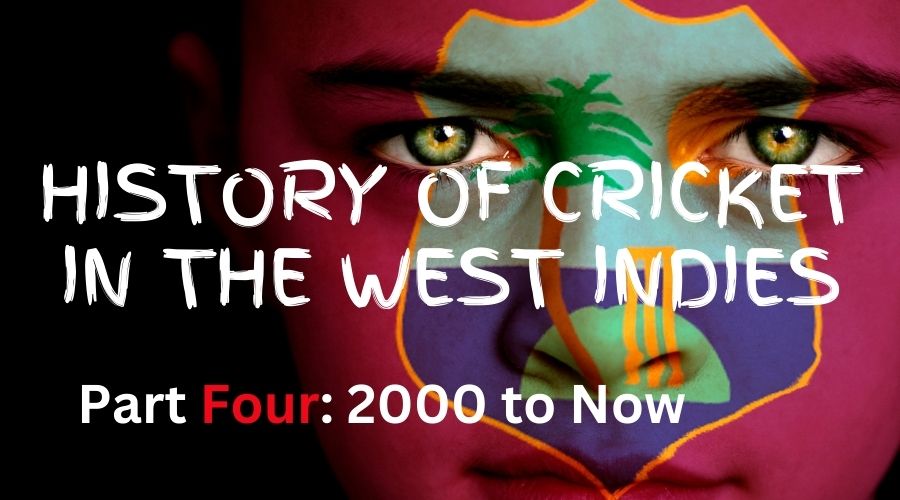Welcome back to the fourth and final post for this particular series, the History of Cricket in West Indies. In our previous post, we discussed the great heights of the 1980s and the sharp decline of the 1990s. Now, we’ll check in on the 21st century.
The 2000s marked a period of significant decline for West Indies cricket. Once a powerhouse in international cricket, the West Indies faced numerous challenges both on and off the field. The decade was characterized by a series of disappointing performances, leadership and captaincy issues, and administrative controversies that contributed to the team’s fall from grace.
The History of Cricket in West Indies: 2000 to 2010
The West Indies cricket team’s decline in the 2000s was dramatic, particularly in Test cricket. After decades of dominance, where they were virtually unbeatable, the West Indies found themselves struggling to compete at the highest level.
Gone were the days of the 1980s when the West Indies won nearly 70% of their tests, and won 2.65 times more often than they lost. In the 2000s, the West Indies won only 1 in 6 tests, and lost nearly 3.3 times as often as they won.
Several factors contributed to this decline. The retirement of key players from the previous era left a significant void in the team. The loss of legends like Courtney Walsh and Curtly Ambrose meant that the team no longer had the world-class fast bowlers who had been their hallmark for decades. The batting lineup, too, was weakened by the departure of experienced players, leaving a young and inexperienced side to take on the best teams in the world.
The team struggled to find consistent performers who could step up and fill the shoes of their predecessors. The West Indies cricket board’s failure to adapt to the evolving nature of the game and invest in youth development programs meant that the pipeline of talent that had once been so rich began to dry up.
Leadership and Captaincy Challenges
The leadership and captaincy of the West Indies team in the 2000s were fraught with challenges and instability. This period saw frequent changes in captaincy, which further contributed to the team’s inconsistent performances. The lack of a stable leadership figure was a significant factor in the team’s struggles, as the constant shuffling of captains did little to foster a sense of continuity and stability.
Brian Lara, one of the greatest batsmen in cricket history, was appointed captain in 1999 and led the team through the early 2000s.
While Lara’s individual performances were exceptional, his tenure as captain was marred by internal conflicts and off-field controversies. Lara’s leadership style, which was often criticized for being autocratic and divisive, created friction within the team.
Following Lara’s resignation in 2007, Shivnarine Chanderpaul and Chris Gayle were appointed as captains at different times. However, they, too, struggled to inspire the team and achieve consistent results.
The frequent changes in leadership and the lack of a clear direction contributed to the team’s poor performances throughout the decade. Without a strong and stable captain to guide them, the West Indies struggled to develop a cohesive team culture and consistently compete against the top teams in the world.
Struggles in Player Development
Another major challenge for West Indies cricket in the 2000s was the struggle to find and develop new talent. The decline of the regional domestic competitions, such as the Shell Shield (later renamed the Carib Beer Cup), meant that there were fewer opportunities for young players to hone their skills and gain valuable experience.
While some promising players emerged during this period, such as Ramnaresh Sarwan, Dwayne Bravo, and Marlon Samuels, they struggled to deliver consistent performances and establish themselves as match-winners. The lack of experienced players to guide them and the absence of a strong domestic foundation meant that these young players often found themselves overwhelmed by the demands of international cricket.
Many players opted to play in more lucrative leagues such as the Indian Premier League (IPL) and the English County Championship, where they could earn higher salaries and gain more exposure.
While these opportunities were beneficial for individual players, they also meant that the national team was often deprived of its best talents.
Off-Field Issues and Their Impact on Team Morale
Off-field issues and administrative controversies were also significant contributors to the decline of West Indies cricket in the 2000s. The West Indies Cricket Board (WICB) was often criticized for its handling of various matters, including player contracts, team selection, and governance.
Disputes between players and the board over pay and conditions were common, leading to strikes and boycotts that further disrupted team preparations and morale.
One of the most notable disputes occurred in 2005 when several senior players, including Brian Lara, Chris Gayle, and Ramnaresh Sarwan, were left out of the team for a home series against South Africa due to a contractual dispute with the WICB.
The absence of these key players significantly weakened the team, and the West Indies suffered a heavy defeat. This incident highlighted the deep-rooted issues within West Indies cricket and the strained relationship between the players and the board.
The Stats: West Indian Stats between 2000 and 2010
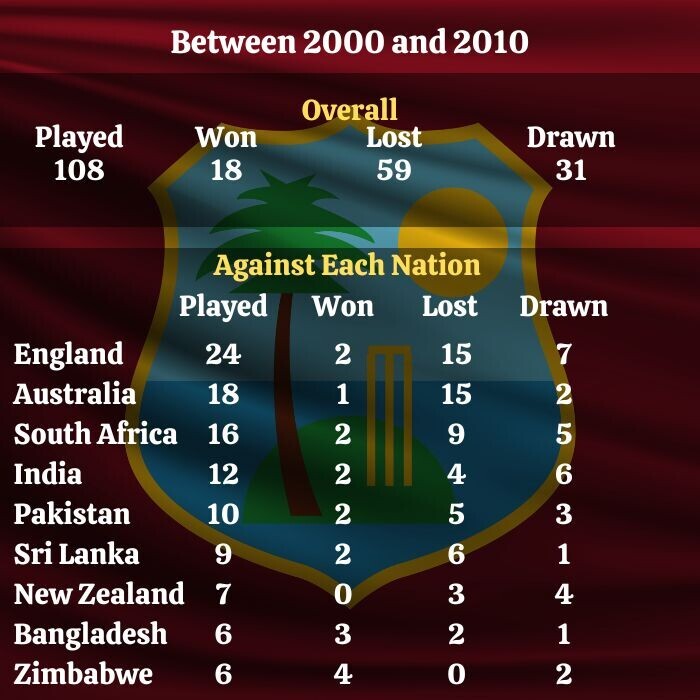
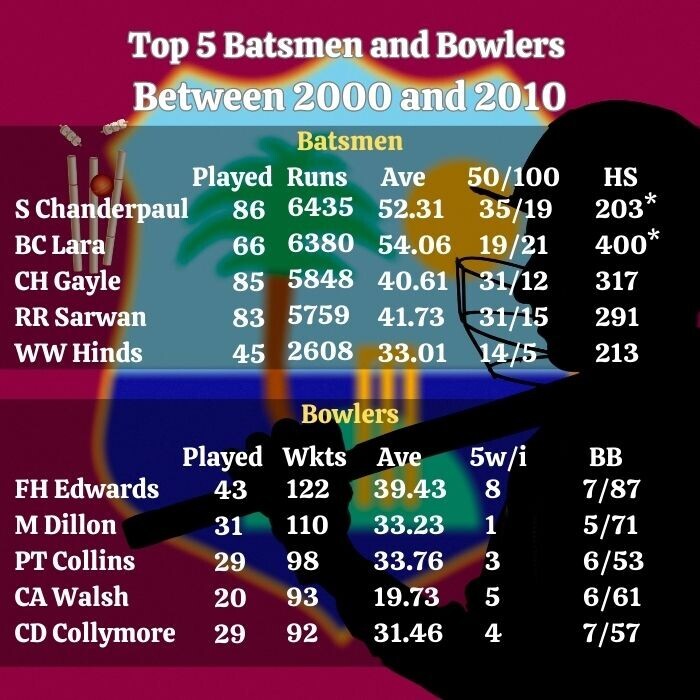
One Day Cricket: World Cup Disappointments
The West Indies’ performance in One Day Internationals (ODIs) during the 2000s was equally disappointing, particularly in the World Cup tournaments.
In the 2003 Cricket World Cup held in South Africa, the West Indies were eliminated in the group stage. Despite some standout performances, including Brian Lara’s century against South Africa, the team was inconsistent and failed to capitalize on crucial moments. Their inability to progress beyond the group stage was a significant blow, highlighting the gap between the West Indies and the top teams in world cricket.
The 2007 World Cup, held in the Caribbean, was seen as an opportunity for the West Indies to regain some pride on home soil. They started well, winning their 3 Pool Games, allowing them to pass through to the Super 8 stage.
But once there, they struggled, winning only 2 of the 7 games.
The poor performances in the World Cups of 2003 and 2007 underscored the decline of West Indies cricket in the 2000s. The team’s inability to compete at the highest level in ODIs, coupled with their struggles in Test cricket, highlighted the need for a comprehensive overhaul of West Indies cricket and a renewed focus on rebuilding for the future.
The Stats: West Indian ODI Stats between 2000 and 2010
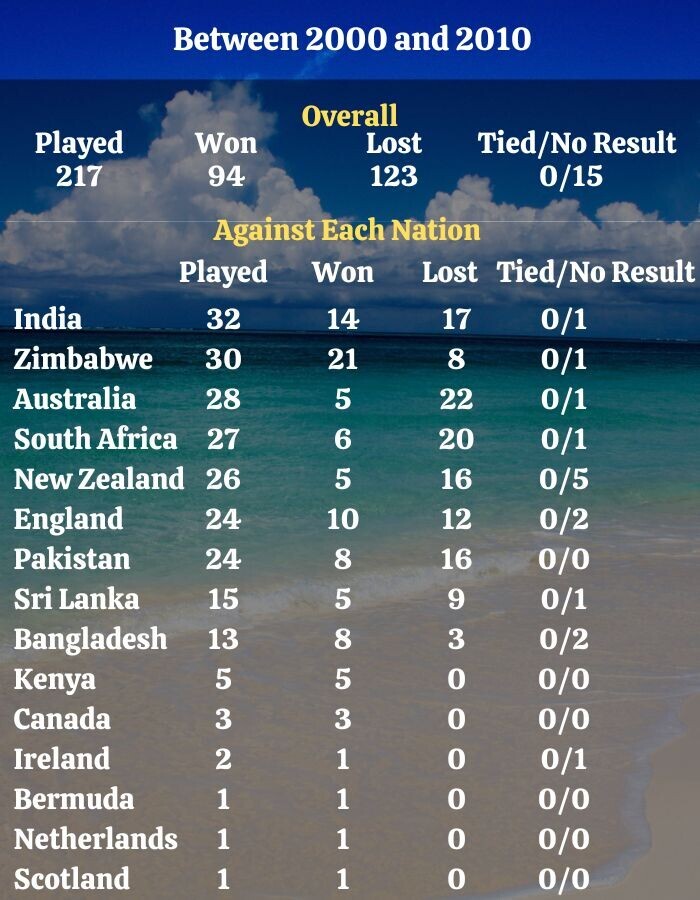
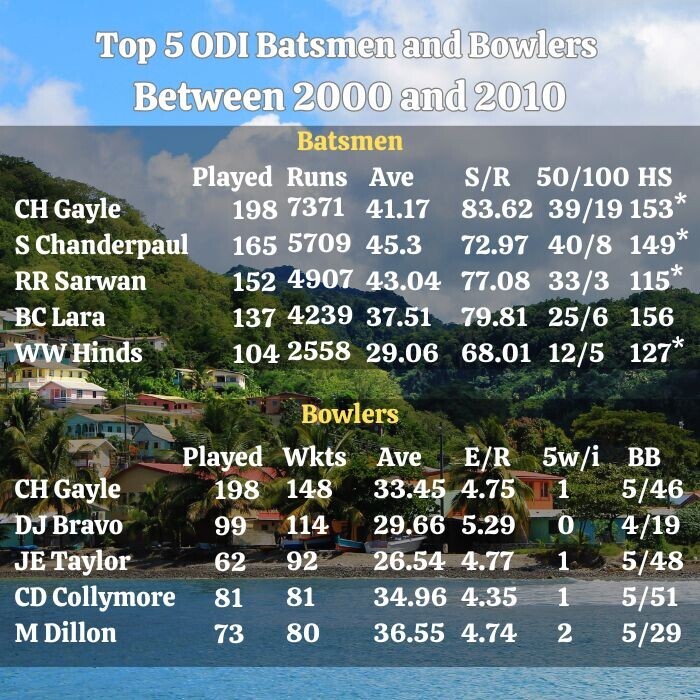
T20 Cricket: The Beginning of a New Era
The 2000s also saw the emergence of T20 cricket, a new format that would eventually play a significant role in the evolution of West Indies cricket. The inaugural T20 World Cup in 2007 marked the beginning of this journey, as the West Indies sought to adapt to the demands of the shorter format.
The 2007 World Cup tournament did not allow for much in the way of build up. The Group Stage was only two games, and West Indies lost both, losing to South Africa despite a Chris Gayle century (117 off 57 balls; the first official T20 century), and then to Bangladesh.
The rise of T20 leagues around the world, such as the Indian Premier League (IPL) and the Big Bash League (BBL), provided lucrative opportunities for West Indian players. Many of them began to prioritize T20 cricket, attracted by the financial rewards and the chance to showcase their skills on a global stage. This shift in focus marked the beginning of a new chapter for West Indies cricket, one that would see them achieve success in the shortest format in the years to come.
In the 2009 T20 World Cup in England, the West Indies reached the Semi Finals. They played Sri Lanka, who batted first and posted 5/158. In response, Chris Gayle played a lone hand, scoring 63 out of a team score of only 101.
But despite this disappointment, the seeds of a new era were sown during this period, as the team began to adapt to the changing landscape of international cricket and explore new opportunities in T20 cricket.
History of Cricket in West Indies – 2010 to 2020
The 2010s were a decade of contrasts for West Indies cricket. On one hand, the team continued to struggle in Test and One Day International (ODI) formats, reflecting the decline that began in the 2000s.
On the other hand, the rise of Twenty20 (T20) cricket brought new opportunities and successes, particularly with the West Indies winning two ICC T20 World Cups. This decade saw the impact of global T20 leagues on West Indies cricket, the emergence of T20 specialists, and ongoing challenges in reviving the longer formats of the game.
The Impact of T20 Leagues on West Indies Cricket
The advent of global T20 leagues in the late 2000s and their rapid rise in popularity had a profound impact on West Indies cricket in the 2010s. Leagues like the Indian Premier League (IPL), the Big Bash League (BBL), and the Caribbean Premier League (CPL) offered lucrative opportunities for cricketers, significantly more than what most could earn playing international cricket for the West Indies.
This financial incentive led many West Indian players to prioritize T20 leagues over national duties. For the players, it was not just about the money; the exposure, experience, and competition level in these leagues also played a significant role in shaping their careers. Players like Chris Gayle, Andre Russell, Dwayne Bravo, and Sunil Narine became household names in the T20 circuit, showcasing their talents to a global audience.
However, the shift in focus towards T20 cricket came at a cost. The West Indies team often found itself fielding weakened squads in Test and ODI formats, as their best players were unavailable due to their commitments in T20 leagues. This lack of consistency in team selection and the absence of key players adversely affected the team’s performance, especially in the longer formats of the game.
West Indies’ Struggles in Test and ODI Formats
Despite some bright moments, the West Indies continued to struggle in Test and ODI formats throughout the 2010s. In Test cricket, the team faced numerous challenges, including a lack of experienced players, inconsistent performances, and a failure to adapt to different conditions. The team’s performance in Test cricket actually improved when compared to the 2000s, winning 27% of their games, but that is comparing against a very low bar.
The Stats: West Indian Stats between 2010 and 2020
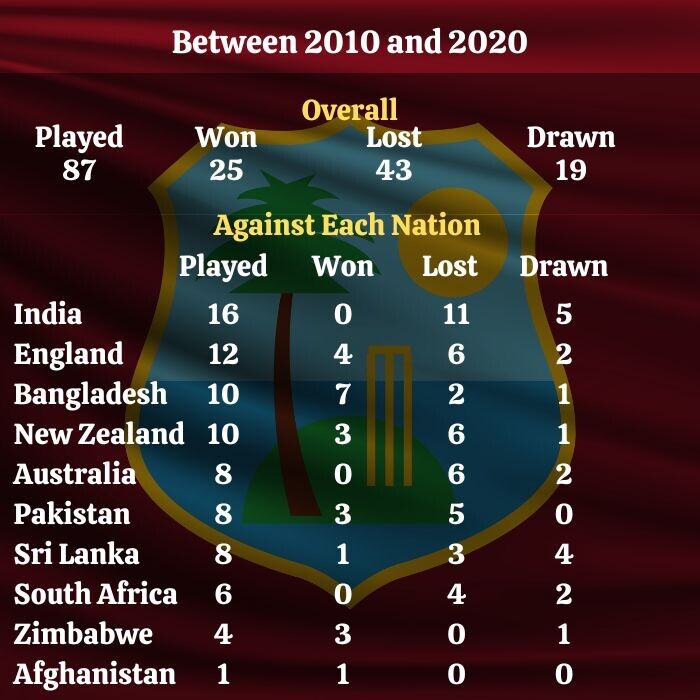
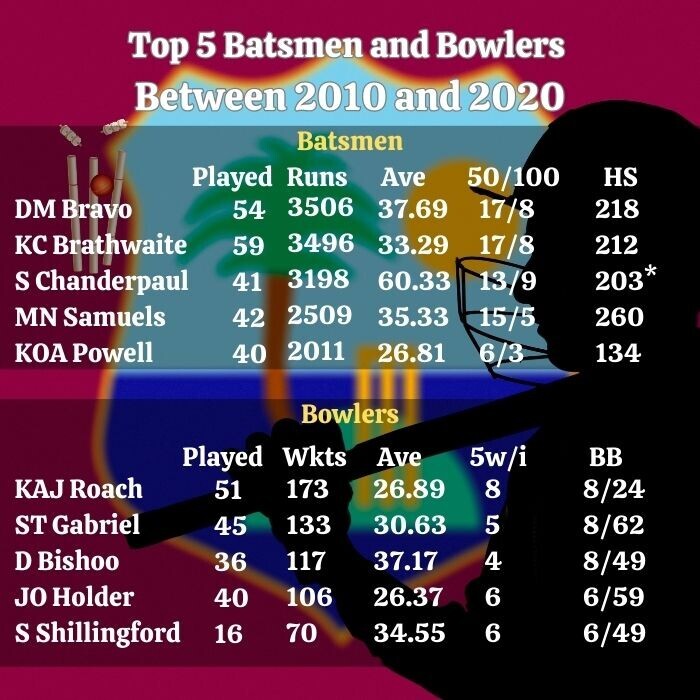
One of the few highlights of the decade came right toward the end, in 2019, when the West Indies defeated England 2-1 in a home Test series, showcasing their potential with a balanced mix of young talent and experienced players. Shannon Gabriel and Kemar Roach led the bowling attack, while Jason Holder, as captain, played a key role in the team’s success.
The first test, in particular, will live in the memories of West Indian fans. Batting first, West Indies put on 289 runs, a middling total, but one that looked enormous by the time England had finished their innings. With Kemar Roach taking 5/17, the English innings lasted just over 30 overs, dismissed for just 77, with no English batsman scoring more than 17.
Instead of enforcing the follow on, West Indies batted again, and reach 52 without lose before an almighty collapse saw them lose 5/9. At 5/61, and with a lead of 273, England had their foot in the door with a possibility for a comeback victory.
The sixth wicket fell at 120, and while the lead was now 333, had the West Indies last 4 wickets collapsed cheaply, England would have considered the chase difficult, but possible.
Enter captain Jason Holder at number 8. He, along with wicket-keeper Shane Dowrich, put together an undefeated partnership of 295, with Dowrich scoring 116 off 224 balls, and Jason Holder 202 off 229 balls, with 23 fours and 8 sixes.
The chase was now 628, with more than 2 days to play. England put up a better fight, but it was Roston Chase who took the spoils, taking 8/60 with his right-arm offbreak.
Unfortunately, such victories were rare, and the West Indies struggled to build on them. Inconsistent selection policies, lack of player commitment, and off-field issues continued to plague the team. The absence of a settled batting lineup and a lack of depth in the bowling attack meant that the West Indies often found themselves outclassed by stronger opponents.
In ODI cricket, the West Indies also faced significant challenges. In the 2011 World Cup, held in India, Sri Lanka, and Bangladesh, the West Indies were knocked out in the quarter-finals by Pakistan, losing by 10 wickets after making only 112. The 2015 World Cup, held in Australia and New Zealand, saw a similar fate, with the West Indies being eliminated in the quarter-finals by New Zealand, who scored 6/393 and won by 143 runs.
And finally, in a World Cup campaign they would prefer to forget, the West Indies won only 2 of their 9 games to come second last, ahead of only Afghanistan.
The Stats: West Indian ODI Stats between 2010 and 2020
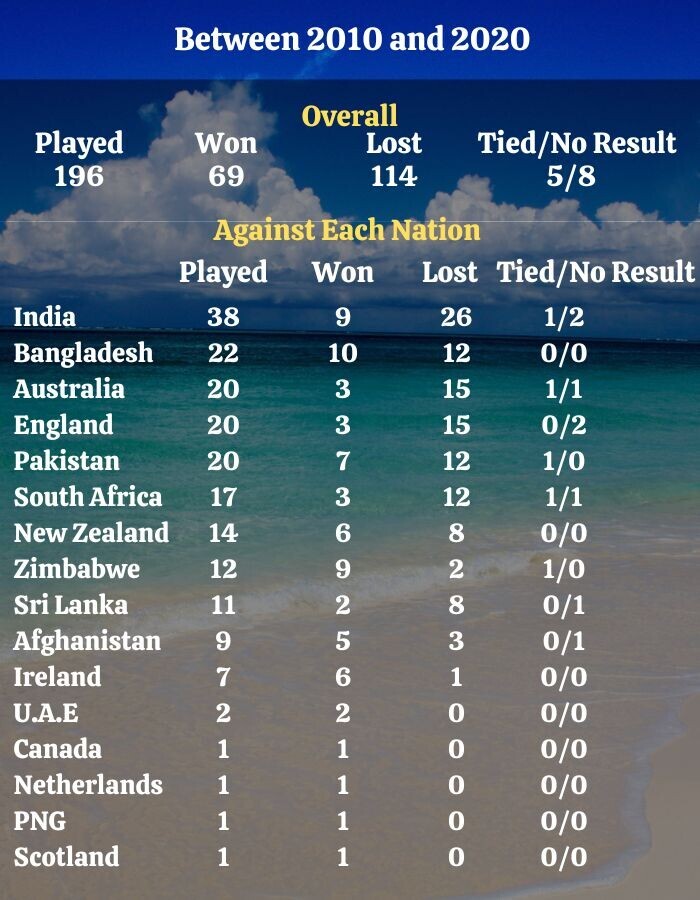
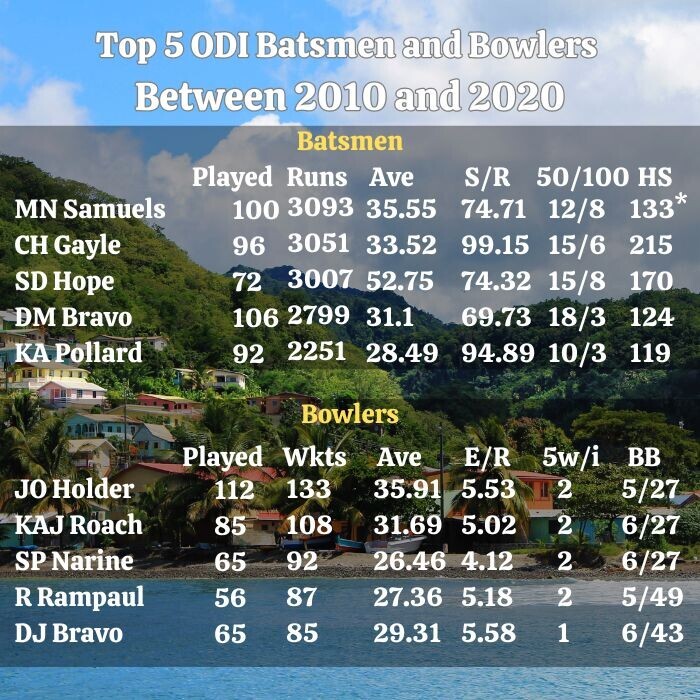
The 2012 ICC T20 World Cup Victory: A Beacon of Hope
Amidst the struggles in Test and ODI formats, the West Indies found solace and success in T20 cricket. The 2012 ICC T20 World Cup, held in Sri Lanka, marked a significant turnaround for West Indies cricket, as they emerged victorious to claim their first T20 World Cup title. This triumph was a beacon of hope for West Indies cricket, showcasing their prowess in the shortest format of the game.
Led by Darren Sammy, the West Indies had a well-balanced squad with a mix of experienced players and young talents. Chris Gayle, known for his explosive batting, was a key figure in the team’s campaign. Sunil Narine, with his mystery spin, was instrumental in restricting the opposition, while Marlon Samuels played a crucial role in the final against Sri Lanka with a match-winning innings.
West Indies were actually very fortunate to even progress past the group stage. Put together with Australia and Ireland, both of West Indies games were rain affected. In their first game, against Australia, they batted first and recorded a very decent score of 8/191. Chasing, Australia were doing well at 1/100 off 9.1 overs when the match was abandoned due to rain. Since the Duckworth/Lewis par score was only 83 at that stage, Australia won the match.
The second game, Ireland batted first and made 6/129 off their 19 overs, a score West Indies would have been confident to chase down. They never got the chance to do so, though, as the match was abandoned before West Indies could start their innings.
In the end, West Indies progressed in second place with just one point, equal to Ireland, and only a slightly better net run rate.
In the Super Eights, West Indies won 2 and lost 1 to come second behind Sri Lanka.
In the semi final against Australia, West Indies once again put on a challenging score, 4/205, thanks to Chris Gayle’s 75 not out off 41 balls. In reply, George Bailey scored 63 off 29 balls, but there was not much else, as Australia was dismissed for 131.
In the final, the West Indies played Sri Lanka. West Indies batted first, and Marlon Samuels was the difference between the two sides, scoring 78 off 56 balls. In reply, Sunil Narine was almost impossible to get away, taking 3/9 from 3.4 overs as Sri Lanka was dismissed for 101.
The 2012 T20 World Cup victory was celebrated across the Caribbean, reigniting passion and pride in West Indies cricket. It also highlighted the team’s potential in T20 cricket, a format that seemed tailor-made for the explosive and unpredictable style of West Indian players. The triumph provided a much-needed boost to the team’s morale and gave fans a reason to believe in the future of West Indies cricket.
Developing T20 Specialists: A New Breed of Players
The success in T20 cricket during the 2010s saw the emergence of a new breed of West Indian players who excelled in the shortest format of the game. These T20 specialists became the face of West Indies cricket, known for their ability to turn matches around with their explosive batting, clever bowling, and athletic fielding.
Andre Russell, Kieron Pollard, Dwayne Bravo, and Sunil Narine were some of the standout performers in T20 cricket during this period. Russell, known for his powerful hitting and death bowling, became a sought-after player in T20 leagues worldwide. Pollard’s ability to finish games with the bat and contribute with the ball made him a valuable asset in T20 cricket. Bravo, with his experience and skill as a death bowler, was a key figure in the West Indies’ T20 success, while Narine’s unique bowling style made him one of the most difficult bowlers to face in T20 cricket.
The rise of these T20 specialists coincided with the global boom in T20 cricket, and West Indian players became highly sought after in leagues around the world. The financial rewards and exposure provided by these leagues not only benefited the players but also brought attention to the talent available in the Caribbean.
The 2016 ICC T20 World Cup Victory
Despite the challenges in Test and ODI cricket, the West Indies continued to find success in T20 cricket during the 2010s, at least in the big tournaments. While overall, West Indies won 43 and lost 53 T20 games during the decade, their performances during the pressure games of big tournaments belief that fact.
In the 2014 tournament in Bangladesh, West Indies made the Semi Finals before a rain-affect Duckworth/Lewis loss to eventual winners, Sri Lanka, ended their campaign.
But in 2016, the West Indies went one further. After topping their group with 3 wins from 4 games (despite losing to Afghanistan), West Indies progressed to the Semi Finals against India. India batted first, with Virat Kohli (89 not out off 47 balls) steering the side to a score of 2/192. In reply, Lendl Simmons top scored with 82 not out from 51 balls, as West Indies scored 3/196 with 2 balls remaining.
The West Indies would meet England in the final. Fielding first, West Indies restricted England to 9/155 from their 20 overs, and despite Marlon Samuels scoring 85, West Indies needed 19 runs from the last over, bowled by Ben Stokes – a difficult proposition.
What happened next would be remembered by all cricket fans, not just those celebrating in the West Indies, or commiserating in England.
Carlos Brathwaite, currently on 10 runs from 6 balls, went 6, 6, 6 and 6, to win the game with 2 balls remaining.
History of Cricket in West Indies: 2020 to now
The 2020s have been a decade of rebuilding and new beginnings for West Indies cricket. After a challenging period in the 2000s and 2010s, marked by inconsistent performances and internal conflicts, the West Indies have embarked on a journey to reclaim their former glory. This decade has seen a renewed focus on domestic cricket, the emergence of young talents, and efforts to blend experience with youth to create a competitive team in all formats.
The emphasis has been on fostering a new generation of cricketers who can excel in the modern game, while also retaining the distinctive flair and spirit that has always characterized West Indies cricket.
One of the key initiatives undertaken by Cricket West Indies (CWI) in the 2020s has been the revamping of the domestic cricket structure. Recognizing the need for a strong domestic foundation to support the national team, CWI introduced several changes aimed at improving the quality of domestic competitions and providing a clear pathway for young players to progress to the international level.
Additionally, CWI has placed greater emphasis on youth development and grassroots cricket. Initiatives such as the Emerging Players Programme and the establishment of academies across the Caribbean have been instrumental in identifying and nurturing young talents.
These programs aim to provide young players with the skills and experience needed to succeed in international cricket, while also instilling a sense of pride and responsibility in representing the West Indies.
Youth and Experience: Blending Generations for Future Success
In the 2020s, the West Indies have adopted a strategy of blending youth and experience to build a competitive team across all formats. The aim has been to create a balanced squad that can draw on the experience of seasoned players while also giving opportunities to young talents who represent the future of West Indies cricket.
Experienced players such as Jason Holder, Kemar Roach, and Kraigg Brathwaite have played a crucial role in guiding the younger members of the team. Holder, in particular, has been a key figure both on and off the field, providing leadership and stability to the team. His all-round abilities and calm demeanour have made him an invaluable asset, especially in Test cricket.
At the same time, the emergence of young players like Alzarri Joseph, Shimron Hetmyer, and Nicholas Pooran has added a new dimension to the team. Joseph’s pace and ability to generate bounce have made him a potent weapon in the bowling attack, while Hetmyer and Pooran’s aggressive batting style has provided the team with much-needed firepower in the middle order.
These players have shown glimpses of their potential and are expected to play a key role in the future of West Indies cricket.
Leadership and Vision: Guiding West Indies Cricket Forward
Leadership has been a critical factor in West Indies cricket’s quest for revival in the 2020s. The appointment of Kraigg Brathwaite as Test captain and Kieron Pollard as the captain of the limited-overs teams has brought a new sense of direction and purpose to the team.
Brathwaite has been tasked with leading the Test side through a period of rebuilding. His leadership style has been characterized by a focus on resilience, hard work, and team unity. Under his captaincy, the West Indies have shown signs of improvement in Test cricket, including a memorable series win against Bangladesh in early 2021, where they chased down 395 runs in the fourth innings, led by the heroics of debutant Kyle Mayers, who scored 210 not out, in the chase.
West Indies’ performances during this decade still leaves a lot to be desired, but there is hope brewing. At the beginning of 2024, West Indies toured Australia for two tests. They were soundly beaten in the first test as their batting only produced scores of 188 and 120, but their bowling heralded an exciting new bowler, Shamar Joseph, who took 5/94.
Fast forward to the second game, as the Gabba in Brisbane, usually a cemetery for visiting teams. West Indies led after the first innings (311 v 9/289 declared), and when West Indies were dismissed for 193, most believed Australia would easily score the 216 required to win.
And Australia’s confidence would have been only increased by an injury to Shamar Joseph during his innings. When Australia went out to bat, Joseph was not to be seen, having his foot checked out at the hospital.
At the end of the day, Australia were 2/60, but Steve Smith was still there, having opened the innings. He and Cameron Green took the Australians to 113 before Green became Shamar Joseph’s first wicket, the bowler having seemingly come back from the dead and now able to bowl again. In just 12 overs of sustained pace and aggression, Shamar Joseph ripped the heart out of the Australia team, taking 7/68, to leave Australia 8 short, dismissed for 207.
It looked like the West Indies had found a new hero to follow.
The Stats: West Indian Stats between 2020 and now
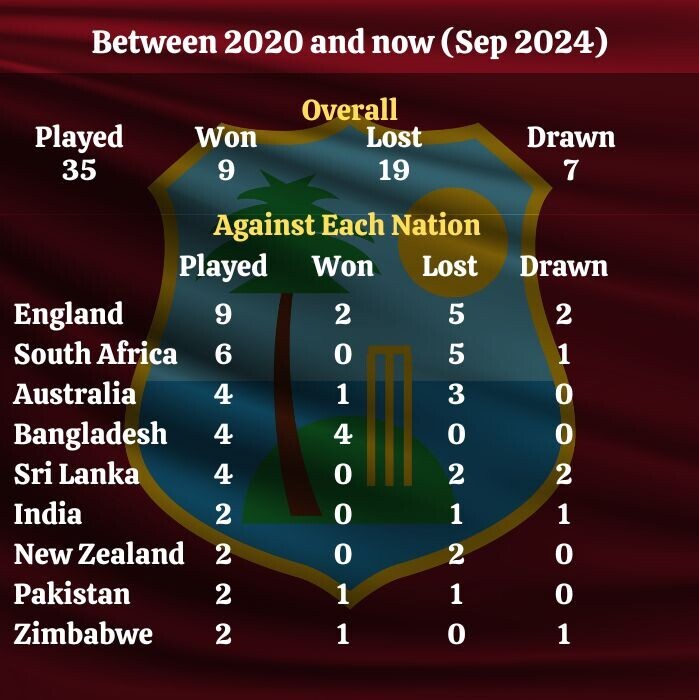
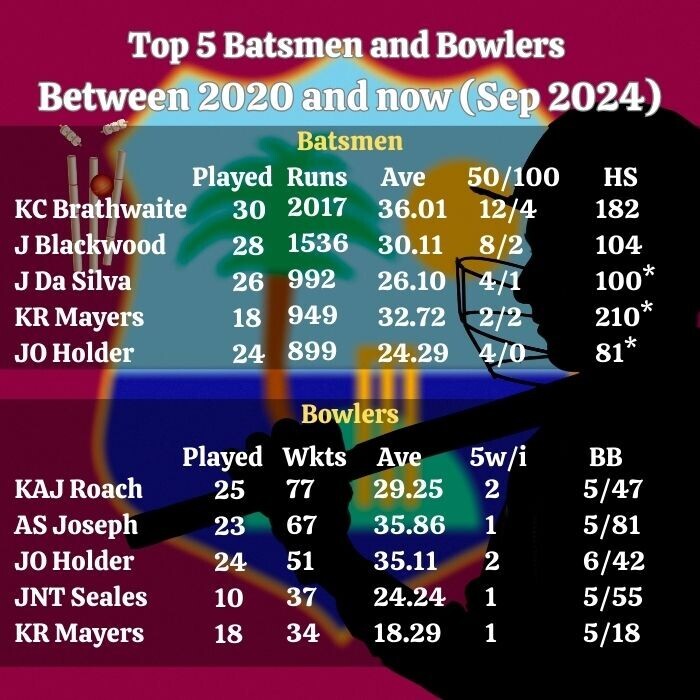
One Day Cricket: Still Struggling
The West Indies’ journey in One Day International (ODI) cricket in the 2020s has been marked by a determination to revive their fortunes and compete with the top teams in the world. While the team has shown glimpses of potential, consistency has been a major issue, and they have struggled to string together a series of strong performances.
It came as a great surprise that the West Indies did not qualify to play for the 2023 World Cup after losing to Scotland in a qualifier match. The fact that the West Indies, the winner of the first two World Cups now could not even qualify for the tournament showed very vividly how far the team had dropped in the intervening decades.
The Stats: West Indian ODI Stats between 2020 and now
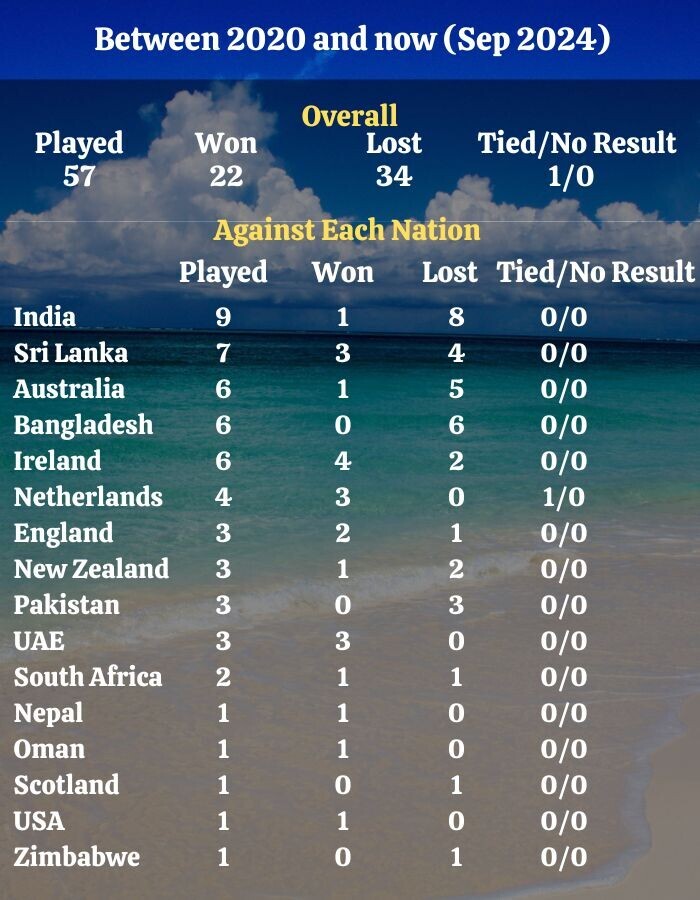
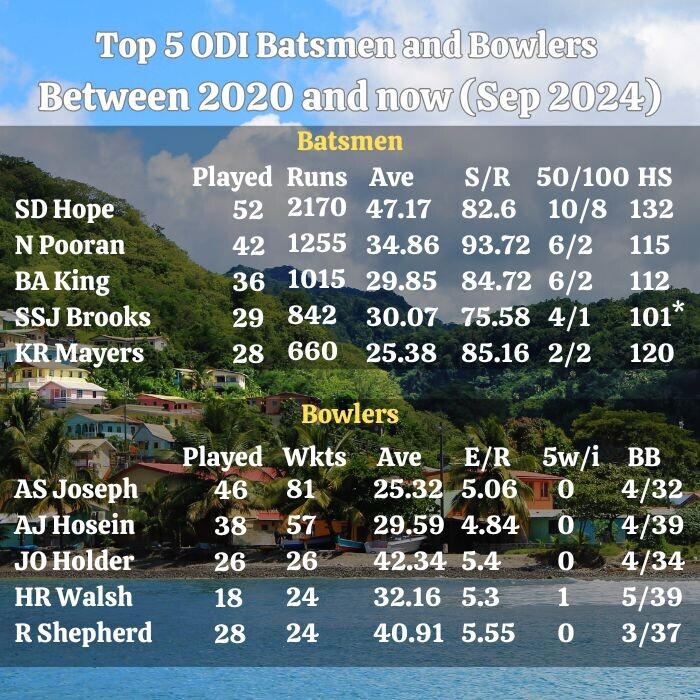
T20 Cricket: The Future of West Indies Cricket
T20 cricket continues to be a major focus for West Indies cricket in the 2020s, with the format offering the team the best chance of success on the global stage.
However, the West Indies’ performance in the 2021 T20 World Cup was disappointing, as they failed to progress beyond the group stage, winning only one game in five.
The 2022 T20 World Cup, held in Australia, offered the West Indies an opportunity to bounce back and reclaim their place among the top T20 teams. However, they again weren’t able to progress past the Group Stage, winning 1 of the 3 games they played.
The West Indies co-hosted the 2024 World Cup with the United States. Their early form was promising: they won each of their four group games to top the group ladder, but they were unable to progress past the Super 8 section of the tournament.
Conclusion
The future of West Indies cricket in the 2020s and beyond is closely tied to their success in T20 cricket. The format provides an opportunity for the team to showcase their natural talents and connect with a global audience.
The 21st century has been a time of rebuilding and new beginnings for West Indies cricket, with a focus on revamping the domestic structure, developing young talent, and finding a balance between youth and experience. While challenges remain, there is a renewed sense of optimism and determination to reclaim the team’s former glory and compete at the highest level in all formats of the game.
We hope you have enjoyed this four-part series on the History of Cricket in the West Indies. The next team we will be putting under the microscope is New Zealand, who first played cricket on the 10th January 1930.
But until then, keep coming back to learn more fascinating skills and facts about the game of cricket, a game with a passionate fanbase spread all throughout the world.

